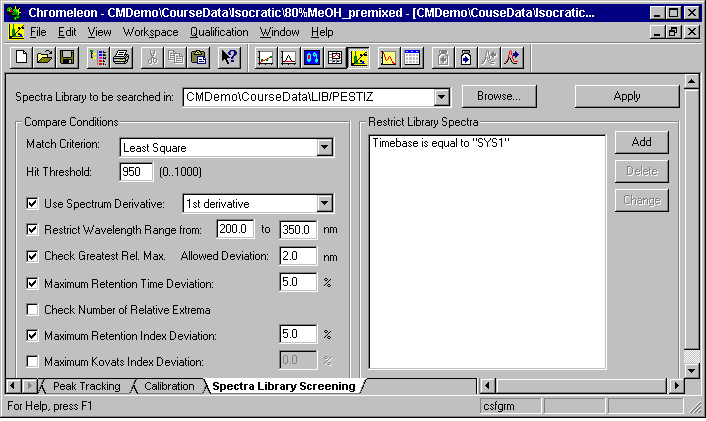Searching Reference Spectra
![]() Entering Criteria for the Spectra Library Screening
Entering Criteria for the Spectra Library Screening
Enter the criteria for a spectra library search on the Spectra Library Screening (= SLS) page of the QNT Editor:

Select a spectra library (LIB file) from the Spectra Library to be searched in field. If the required LIB file is not included, click the Browse button to search for the file.
In the Match Criterion field, select the method (see Match Criterion) used for comparing the original spectrum and the library. The best search results are usually received via the setting Least Square.
In the Hit Threshold field, enter a Match Factor between 0 and 1000; for example, 950. Only spectra with a match value above 950 will be shown. Spectra with less similarity will not be included. Unless derivatives of spectra are compared with each other, reference spectra with a match value below 900 are usually spectra of other substances. Exceptions to this rule are only acceptable, if the signal-to-noise ratio is low.
![]() Note:
Note:
To be able to compare UV spectra, the spectrum and the reference spectrum should be recorded under identical conditions. For best results, create your own library of spectra you recorded yourself.
Additional conditions are possible to perform a more exact search:
Usually, the Use Spectrum Derivative option is disabled; that is, the comparison of spectra is based on their actual curve. If the 1st derivative option is selected, the comparison of two spectra is based on the first derivative. As a result, the curve characteristics increase (shoulders become extrema), allowing a more exact comparison of extrema. However, the signal-to-noise ratio will considerably decrease; and sections with lower signals will be less significant.
Select Restrict Wavelength Range to limit the spectra comparison to the relevant spectral range.
Select Check Greatest Rel. Max. to use only spectra with the greatest relative maximum at the same position. Select Allowed Deviation to specify a tolerance range. The range should not exceed 10 nm to avoid that the criterion loses significance.
Click Maximum Retention Time Deviation to determine the maximum retention time deviation of the reference spectrum in percent. This prevents including substances with very similar spectra that are eluted at different retention times.
If you select Check Number of Relative Extrema, Chromeleon checks the number of relative extrema of the reference spectrum. Select this option to exclude spectra that are very similar but have an additional maximum.
Select Maximum Retention Index Deviation: or Maximum Kovats Index Deviation: to include only those spectra in the comparison for which the retention index or, respectively, the Kovats Index is identical with the index of the sample substance. The respective tolerances are defined in the right field.
![]() Tip
Tip
With an increased noise level, noise peaks can be considered extrema. In this case, Dionex recommends disabling Check Number of Relative Extrema.
On the right side of the window, you can further restrict the resulting library spectra:
Click Add to open the Restrict Library Search dialog box .
In the Field Name field, select type of parameter to be determined from the following search criteria:
|
Solvent Composition |
Detector Serial Number |
|
Control Program |
Timebase |
|
Substance Name |
Sequence Name |
|
Unique ID |
Sample Name |
|
Comment |
Extract Operator |
|
Detector Name |
|
These items can be linked (partly) via the following operators (Conditions) with a freely selectable value:
|
Operator |
Restricts the search to spectra with parameters that |
|
is equal to: |
fulfill the specified condition. |
|
starts with: |
start with the entered string. |
|
does not start with: |
do not start with the entered string. |
|
ends with: |
end with the entered string. |
|
does not end with: |
do not end with the entered string. |
|
contains: |
contain the entered string. |
|
does not contain: |
do not contain the entered string. |
![]() Note:
Note:
If you want to search all libraries in a directory, simply enter the character * as the file name. The common wildcard characters * and ? are valid. Example: LIB::\CMDATA\LIB\D* searches all libraries starting with the letter D in the directory LIB of the datasource CMDATA.